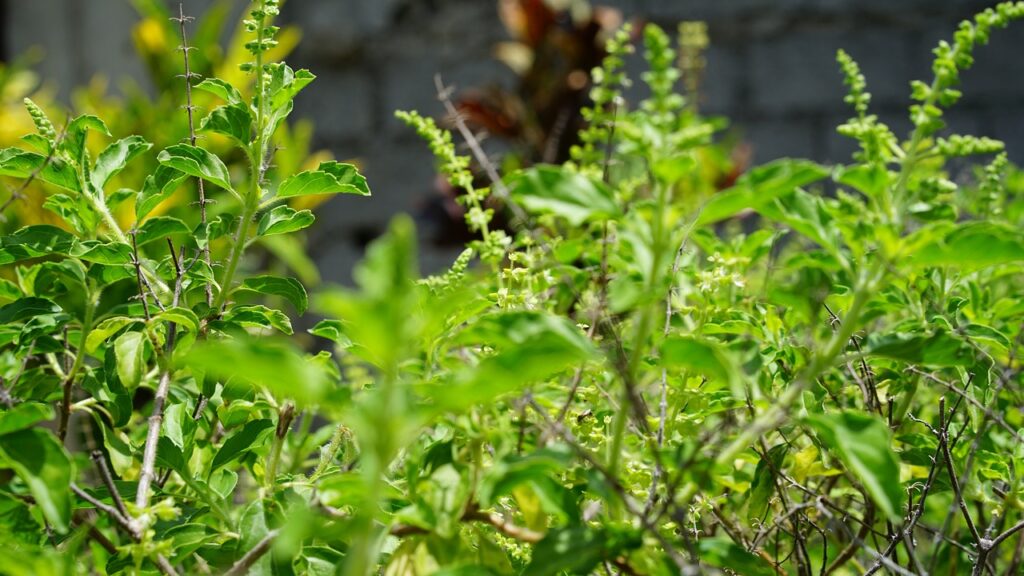Tulsi, also known as Holy Basil (Ocimum sanctum), is a revered herb in many cultures, particularly in India, where it is considered sacred. Growing Tulsi at home is a rewarding experience, offering both spiritual and health benefits. This guide will walk you through the steps to successfully cultivate this wonderful herb in your garden or home.
Benefits of Growing Tulsi
Tulsi is not just a plant; it’s a powerhouse of medicinal properties. It is known for:
Immune-boosting properties: Tulsi is rich in antioxidants and helps enhance the body’s natural defense against infections.
Stress relief: The herb is known for its adaptogenic properties, which help the body adapt to stress and promote mental balance.
Respiratory benefits: Tulsi is beneficial for respiratory health, helping to relieve conditions like asthma, bronchitis, and the common cold.
Skin health: The antimicrobial properties of Tulsi help in treating skin infections and acne.
Choosing the Right Variety
There are several varieties of Tulsi, but the most common ones are:
Rama Tulsi: Known for its green leaves and mild flavor.
Krishna Tulsi: Characterized by its purple leaves and a slightly stronger taste.
Vana Tulsi: A wild variety with a more robust growth habit and potent aroma.
Growing Conditions
Tulsi is a hardy plant that can thrive in various conditions, but it prefers:
Warm Climate: Tulsi grows best in temperatures between 70°F to 90°F (20°C to 32°C).
Sunlight: It needs at least 6-8 hours of direct sunlight daily. In regions with harsh sunlight, partial shade during peak hours is beneficial.
Soil: Well-draining soil rich in organic matter is ideal. A pH level between 6.0 and 7.5 is optimal.
Watering: Tulsi prefers moist soil but not waterlogged. Water the plant when the topsoil feels dry to the touch.
Planting Tulsi
From Seeds:
Sow the seeds in a pot or garden bed with well-prepared soil.
Cover the seeds lightly with soil, about 1/4 inch deep.
Water gently to keep the soil moist but not soggy.
Seeds usually germinate in 1-2 weeks.
From Cuttings:
Take a healthy cutting from an established Tulsi plant.
Remove the lower leaves and dip the cut end in rooting hormone (optional).
Plant the cutting in moist soil or water until roots develop.
Transplant the cutting into a pot or garden bed once roots are well-formed.
Caring for Tulsi
Watering: Maintain consistent moisture in the soil. Water more frequently during hot, dry periods.
Fertilizing: Use organic fertilizers like compost or well-rotted manure. Avoid chemical fertilizers as they can harm the plant.
Pruning: Regular pruning encourages bushier growth. Pinch off the flowers to prevent the plant from becoming leggy.
Pest Control: Tulsi is generally pest-resistant, but occasional issues with aphids or whiteflies can occur. Use neem oil or insecticidal soap to manage pests.
Harvesting Tulsi
Start harvesting leaves once the plant is well-established, usually after 6-8 weeks.
Harvest leaves early in the morning for the best flavor and aroma.
Avoid over-harvesting; always leave enough leaves for the plant to continue growing vigorously.
Using Tulsi
Tea: Tulsi leaves can be used to make a soothing herbal tea.
Culinary: Add fresh leaves to salads, soups, and dishes for a unique flavor.
Medicinal: Use leaves in homemade remedies for colds, coughs, and skin treatments.
Growing Tulsi is a fulfilling endeavor that brings numerous benefits to your home and health. With the right conditions and care, you can enjoy the beauty and utility of this sacred herb year-round. Whether you are an experienced gardener or a beginner, Tulsi is a wonderful addition to your garden, offering a blend of aesthetic beauty, aromatic delight, and therapeutic value.
Troubleshooting Common Issues
While Tulsi is a hardy and relatively easy plant to grow, you may encounter some issues. Here are common problems and solutions:
Yellowing Leaves
Cause: Overwatering, poor drainage, or nutrient deficiency.
Solution: Ensure well-draining soil and avoid waterlogging. Use a balanced organic fertilizer to replenish nutrients.
Wilting
Cause: Underwatering or root rot.
Solution: Water the plant consistently, allowing the soil to dry slightly between waterings. Check for signs of root rot and trim any affected roots.
Pests
Cause: Aphids, whiteflies, or spider mites.
Solution: Spray with neem oil or insecticidal soap. Encourage beneficial insects like ladybugs to control pest populations naturally.
Poor Growth
Cause: Insufficient sunlight, poor soil quality, or incorrect pH levels.
Solution: Ensure the plant receives 6-8 hours of sunlight daily. Amend the soil with compost to improve fertility and check soil pH, adjusting as necessary.
Winter Care for Tulsi
In regions with cold winters, Tulsi requires special care:
Bring Indoors: Before the first frost, move potted Tulsi plants indoors to a sunny window.
Reduce Watering: Water less frequently during winter, as the plant’s growth slows down.
Maintain Humidity: Tulsi prefers a humid environment. Use a humidifier or place a tray of water near the plant to increase humidity.
Propagating Tulsi
Propagating Tulsi can help you expand your herb garden or share plants with friends:
Seeds: Collect seeds from mature flowers and store them in a cool, dry place for the next planting season.
Cuttings: As mentioned earlier, take cuttings from a healthy plant and root them in water or soil.
Varieties and Their Unique Benefits
Understanding the different varieties of Tulsi can help you choose the right one for your needs:
Rama Tulsi: Ideal for making tea, known for its calming properties.
Krishna Tulsi: Slightly spicier flavor, great for culinary uses.
Vana Tulsi: Wild variety with a strong aroma, excellent for medicinal purposes.
Cultural and Spiritual Significance
In addition to its health benefits, Tulsi holds significant cultural and spiritual value, especially in Hinduism:
Sacred Plant: Tulsi is considered an incarnation of the goddess Tulsi (a manifestation of Lakshmi) and is worshipped in many Hindu households.
Protective Aura: It is believed to create a positive environment and ward off negative energies.
Daily Rituals: Many families perform daily rituals involving Tulsi, such as watering the plant and lighting a lamp near it in the evening.
Growing Tulsi is not only a horticultural activity but also a journey into a tradition steeped in cultural, spiritual, and medicinal significance. By following the right growing conditions and care practices, you can enjoy the myriad benefits this sacred herb offers. Whether you are looking to boost your health, enhance your garden, or embrace a spiritual practice, Tulsi is a wonderful addition to your life. Happy gardening!






